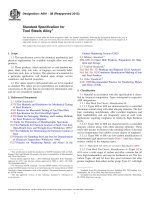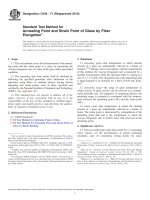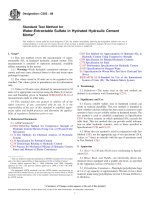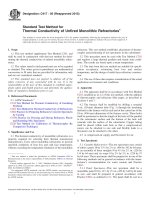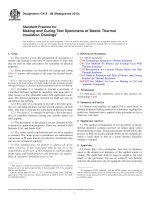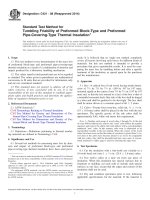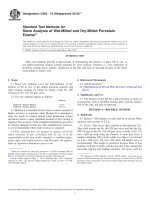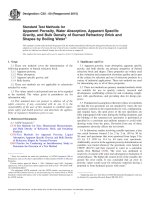Astm c 430 08 (2015)
Bạn đang xem bản rút gọn của tài liệu. Xem và tải ngay bản đầy đủ của tài liệu tại đây (70.18 KB, 3 trang )
Designation: C430 − 08 (Reapproved 2015)
Standard Test Method for
Fineness of Hydraulic Cement by the 45-µm (No. 325) Sieve1
This standard is issued under the fixed designation C430; the number immediately following the designation indicates the year of
original adoption or, in the case of revision, the year of last revision. A number in parentheses indicates the year of last reapproval. A
superscript epsilon (´) indicates an editorial change since the last revision or reapproval.
3.1.2 Sieve Cloth or Electroformed Sheet—The sieve frame
shall be fitted with either a 45-µm (No. 325) stainless steel AISI
Type 304 woven-wire sieve cloth, conforming to the requirements of Specification E11 or a 45-µm electroformed reinforced nickel sieve sheet conforming to the requirements of
Specification E161 with the exception that the number of
openings shall be 71 6 2 per linear centimetre (180 6 5 per
linear inch).
3.1.3 Cloth or Sheet Mounting:
3.1.3.1 Woven-Wire Cloth Mounting—Type 304 stainless
steel woven-type cloth shall be mounted in the frame without
distortion, looseness, or wrinkling. For a sieve fabricated by
soldering the cloth to the frame, the joint shall be made smooth
to prevent the cement from catching in the joints between the
sieve cloth and the frame. Two-piece sieves shall clamp tightly
on the cloth to prevent the cement from catching in the joints
between the sieve cloth and the frame.
3.1.3.2 Electroformed
Sieve
Sheet
Mounting—
Electroformed reinforced nickel sieve sheet shall be mounted
in the frame without distortion, looseness, or wrinkling. The
joint between the sieve cloth and the frame shall be made
smooth with a material impervious to water.
1. Scope*
1.1 This test method covers the determination of the fineness of hydraulic cement by means of the 45-µm (No. 325)
sieve.
1.2 The values stated in SI units are to be regarded as the
standard. The inch-pound equivalents of SI units may be
approximate.
1.3 This standard does not purport to address all of the
safety concerns, if any, associated with its use. It is the
responsibility of the user of this standard to establish appropriate safety and health practices and determine the applicability of regulatory limitations prior to use.
2. Referenced Documents
2.1 ASTM Standards:2
E11 Specification for Woven Wire Test Sieve Cloth and Test
Sieves
E161 Specification for Precision Electroformed Sieves
E177 Practice for Use of the Terms Precision and Bias in
ASTM Test Methods
3. Apparatus
3.2 Spray Nozzle—The spray nozzle (Fig. 1) shall be constructed of metal not subject to corrosion by water and shall be
17.5 mm (0.69 in.) in inside diameter with a central hole drilled
in line with the longitudinal axis, an intermediate row of eight
holes drilled 6 mm (0.23 in.) center-to-center at an angle of 5°
from the longitudinal axis, and an outer row of eight holes
drilled 11 mm (0.44 in.) center-to-center at an angle of 10°
from the longitudinal axis. All holes shall be 0.5 mm (0.02 in.)
in diameter. The spray nozzle shall have been checked within
six months prior to testing a cement sample to ensure that the
flow rate is between 1500 and 3000 g/min at 69 6 3 kPa (10
6 0.4 psi).
3.1 Sieve:
3.1.1 Sieve Frame—The sieve frame shall be of metal not
subject to corrosion by water and shall be circular, either 51 6
6 mm (2.0 6 0.25 in.) when woven-wire cloth is mounted in
the frame or 76 6 6 mm (3.0 6 0.25 in.) in diameter when an
electroformed sheet is mounted in the frame. The depth of the
sieve from the top of the frame to the cloth or sheet shall be 76
6 6 mm (3.0 6 0.25 in.). The frame shall have either side walls
of 89 6 6 mm (3.5 6 0.25 in.) in total height, or legs at least
12 mm (0.5 in.) in length, sufficient to allow air circulation
beneath the sieve cloth or electroformed sheet.
3.3 Pressure Gage—The pressure gage shall be 76 mm (3.0
in.) minimum diameter, and shall be graduated in 7-kPa (1-psi)
increments, and shall have a maximum capacity of 207 kPa (30
psi). The accuracy at 69 kPa (10 psi) shall be 62 kPa (60.25
psi).
1
This test method is under the jurisdiction of ASTM Committee C01 on Cement
and is the direct responsibility of Subcommittee C01.25 on Fineness.
Current edition approved Oct. 1, 2015. Published October 2015. Originally
approved in 1959. Last previous edition approved in 2008 as C430 – 08. DOI:
10.1520/C0430-08R15.
2
For referenced ASTM standards, visit the ASTM website, www.astm.org, or
contact ASTM Customer Service at For Annual Book of ASTM
Standards volume information, refer to the standard’s Document Summary page on
the ASTM website.
4. Calibration of 45-µm (No. 325) Sieve
4.1 Place 1.000 g of the current lot of National Institute of
Standards and Technology standard sample No. 114 or No. 46h
*A Summary of Changes section appears at the end of this standard
Copyright © ASTM International, 100 Barr Harbor Drive, PO Box C700, West Conshohocken, PA 19428-2959. United States
1
C430 − 08 (2015)
NOTE 2—Care should be taken not to heat the sieve hot enough to soften
the solder.
6. Cleaning of 45-µm (No. 325) Sieves
6.1 Frequency of Cleaning and Calibration—Sieves fitted
with woven wire sieve cloth shall be cleaned after no more than
five determinations. Sieves fitted with an electroformed reinforced sieve sheet having 71 openings per linear centimetre
shall be cleaned after no more than three determinations. Both
types of sieves shall be recalibrated after no more than 100
determinations.
6.2 Acceptable Cleaning Procedures—One option for cleaning is to place the sieve in a low-power (150 W maximum
power input) ultrasonic bath containing an appropriate laboratory cleaning solution. The bath is to be operated for sufficient
time (approximately 10 to 15 min at room temperature) to
remove particles lodged in the openings. Be apprised that
electroformed sieve sheets containing more than 71 openings
per linear centimetre may well be damaged by ultrasonic
cleaning. An option for cleaning which does not require an
ultrasonic bath can also be employed. Immerse the sieve in a
bath of appropriate laboratory cleaning solution heated to just
below boiling point. Cover with a watch glass to reduce
evaporation. Continue this soaking for a time sufficient to
loosen lodged particles with a rinse following the bath.
Overnight soaking in similar but unheated cleaning solutions is
also acceptable, provided a rinse following the bath is able to
wash away lodged particles. Cleaning or rinsing with dilute
hydrochloric or acetic acid solutions is to be avoided. Appropriate cleaning solutions are restricted to soap or detergent-type
solutions.
FIG. 1 Spray Nozzle with Seventeen 0.02-in. (0.51-mm) Holes
on the clean, dry, 45-µm (No. 325) sieve and proceed as in
Section 5. The sieve correction factor is the difference between
the test residue obtained and the assigned residue value
indicated by the electroformed sheet sieve fineness specified
for the standard sample, expressed as a percentage of the test
residue.
NOTE 1—It should be observed that the sieve correction as specified is
a factor to be multiplied by the residue obtained and that the amount to be
added to or subtracted from the residue in any given test is therefore
proportional to the amount of residue.
7. Calculation
Example of Determination of Sieve Correction Factor:
Residue on 45-µm (No. 325) Sieve, sample No. 114
or No. 46h
Residue for a 1-g sample
Residue on sieve being calibrated
Difference
Correction factor = + 0.029 ⁄ 0.093 × 100 = + 31.18
7.1 Calculate the fineness of the cement to the nearest 0.1 %
as follows:
12.2 %
=
=
0.122 g
0.093 g
+ 0.029 g
+ 31.2 %
R c 5 R s 3 ~ 1001C !
(1)
F 5 100 2 R c
(2)
where:
F = fineness of the cement expressed as the corrected
percentage passing the 45-µm (No. 325) sieve,
Rc = corrected residue, %,
Rs = residue from the sample retained on the 45-µm (No.
325) sieve, g, and
C = sieve correction factor (determined as prescribed in
Section 4) which may be either plus or minus.
Example:
5. Procedure
5.1 Place a 1.000 g sample of the cement on the clean, dry
45-µm (No. 325) sieve. Wet the sample thoroughly with a
gentle stream of water. Remove the sieve from under the
nozzle and adjust the pressure on the spray nozzle to 69 6 4
kPa (10 6 0.5 psi). Return the sieve to its position under the
nozzle and wash for 1 min, moving the sieve with a circular
motion in a horizontal plane at the rate of one motion per
second in the spray. The bottom of the spray nozzle should
extend below the top of the sieve frame about 12 mm (0.5 in.).
Immediately upon removing the sieve from the spray, rinse
once with about 50 cm3 of distilled or deionized water, using
caution not to lose any of the residue, and then blot the lower
surface gently upon a damp cloth. Dry the sieve and residue in
an oven or over a hot plate (see Note 2), supporting the sieve
in such a manner that air may pass freely beneath it. Cool the
sieve; then brush the residue from the sieve and weigh on an
analytical balance capable of reproducing results within 0.0005
g.
Sieve correction factor, C
Residue from sample being tested, Rs
Corrected residue, Rc
Corrected amount passing, F
=
=
=
=
=
+31.2 %
0.088 g
0.088 × (100 + 31.2)
11.5 %
100 − 11.5 % = 88.5 %
8. Precision and Bias
8.1 Normal Fineness Product—The multilaboratory precision has been found to be 60.75 % (IS) as defined in Practice
E177, therefore, results of properly conducted tests from two
different laboratories on identical samples of cement should
agree 95 % of the time within 62.1 %.
2
C430 − 08 (2015)
8.2 High Fineness Product—The multilaboratory precision
has been found to be 60.50 % (IS) as defined in Practice E177;
therefore, results of properly conducted tests from two different
laboratories on identical samples of cement should agree 95 %
of the time within 61.4 %.
8.3 Since there is no accepted reference material suitable for
determining the bias for the procedure in this test method, no
statement on bias is being made.
9. Keywords
NOTE 3—The use of outside threads instead of inside threads as shown
in this figure is permissible.
9.1 fineness of hydraulic cement
SUMMARY OF CHANGES
Committee C01 has identified the location of selected changes to this test method since the last issue,
C430 – 96(2003), that may impact the use of this test method. (Approved December 1, 2008)
(1) Revised 4.1.
ASTM International takes no position respecting the validity of any patent rights asserted in connection with any item mentioned
in this standard. Users of this standard are expressly advised that determination of the validity of any such patent rights, and the risk
of infringement of such rights, are entirely their own responsibility.
This standard is subject to revision at any time by the responsible technical committee and must be reviewed every five years and
if not revised, either reapproved or withdrawn. Your comments are invited either for revision of this standard or for additional standards
and should be addressed to ASTM International Headquarters. Your comments will receive careful consideration at a meeting of the
responsible technical committee, which you may attend. If you feel that your comments have not received a fair hearing you should
make your views known to the ASTM Committee on Standards, at the address shown below.
This standard is copyrighted by ASTM International, 100 Barr Harbor Drive, PO Box C700, West Conshohocken, PA 19428-2959,
United States. Individual reprints (single or multiple copies) of this standard may be obtained by contacting ASTM at the above
address or at 610-832-9585 (phone), 610-832-9555 (fax), or (e-mail); or through the ASTM website
(www.astm.org). Permission rights to photocopy the standard may also be secured from the Copyright Clearance Center, 222
Rosewood Drive, Danvers, MA 01923, Tel: (978) 646-2600; />
3
